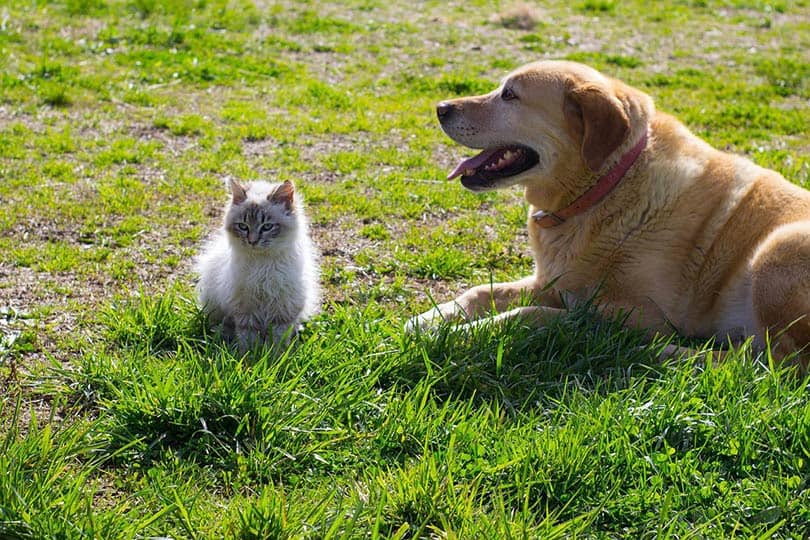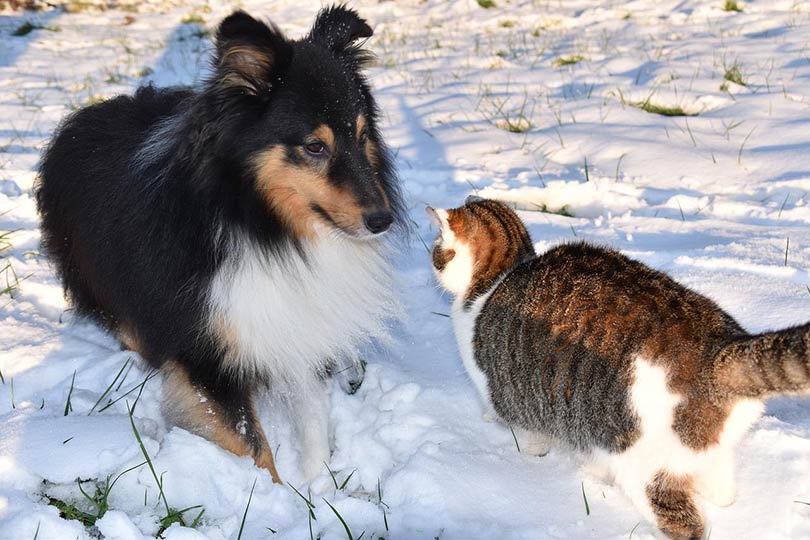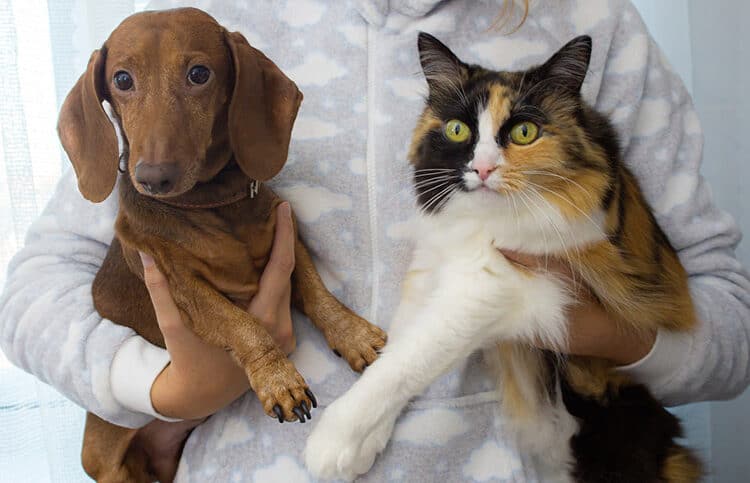There is a long-standing debate about which animal is smarter: dogs or cats. It’s hard to say for sure, as both animals have their own unique forms of intelligence. Scientific tests point to dogs as being just slightly smarter than cats, but this isn’t a hard fact. Cats have their own special kinds of intelligence. Here are some interesting points to consider.
How Do We Know If Animals Are Smart?
Intelligence Testing
Intelligence testing in animals dates back to the early 1900s, when psychologist Edward Thorndike designed a puzzle box to study animal learning. The box would release a door if the animal pressed a lever inside – and Thorndike found that animals quickly learned how to escape. Since then, intelligence tests have been designed for all sorts of animals – including cats and dogs.
So, Who’s Smarter – Cats or Dogs?
Let’s take a closer look. For this thought exercise, we will rate the intelligence of cats and dogs using the following criteria, which are the areas of intelligence most studied by scientists:
- Brain size and makeup
- Emotional intelligence
- Self-awareness
- Empathy
- Problem-solving
- Memory and learning
- Reading human emotions

1. Brain Size and Makeup
Dogs have twice as many neurons as dogs. But does this mean they’re smarter? Not necessarily. Studies have shown that brain size doesn’t always correlate with intelligence. For example, ravens have much smaller brains than chimpanzees – but they’re considered to be just as intelligent.
The way the brain is organized also plays a role in intelligence. For example, a recent study found that dogs have more neurons in their cerebral cortex than cats. This suggests that dogs may be better at complex problem-solving and reasoning than cats. This may be why dogs are better at tasks like learning tricks and following commands.
2. Emotional Intelligence
One area where cats may have an advantage over dogs is emotional intelligence. Cats are more in tune with their owner’s emotions and can even learn to read facial expressions. This may be because cats evolved to be solitary hunters, while dogs evolved to hunt in packs. As a result, dogs are better at reading other dogs’ emotions, while cats are better at reading human emotions.
3. Self-Awareness
A recent study found that dogs are more self-aware than cats. This means they’re aware of their own mental states – for example, that they want to go for a walk or that they’re hungry. The study used a mirror test, in which animals are placed in front of a mirror and see their reflection for the first time. If they touch the reflection, it’s a sign that they understand it’s their own reflection.
So far, only a handful of animals have passed this test – including dogs, chimpanzees, elephants, and dolphins. But not a single cat has ever passed. This may be because cats simply don’t care about their own appearance – or because they’re not as self-aware as dogs.
4. Empathy
Empathy is the ability to understand and share the emotions of another. Dogs are much better at this than cats. For example, dogs will comfort their owners when they’re sad or anxious – whereas cats could care less.
5. Problem-Solving
Cats are better at problem-solving than dogs. This is because they’re more independent and less reliant on humans. For example, a cat can figure out how to open a door by itself – whereas a dog will just sit there and bark.
6. Memory and Learning
Dogs have better memories than cats. This is because they’re able to remember things for longer periods of time. For example, a dog can remember its owner’s face after months of separation – whereas a cat will forget its owner’s face after just a few days.
This difference may be due to the size of the hippocampus. The hippocampus is the part of the brain responsible for memory, and it’s proportionally larger in dogs than in cats. This may explain why dogs have such good memories.
7. Reading Human Emotions
One area where cats may have an advantage over dogs is emotional intelligence. Cats are more in tune with their owner’s emotions and can even learn to read facial expressions. This may account for the feeling dog owners get when they think their pet understands their emotions.

Who Wins In Each Category?
- Brain size and makeup: Dogs
- Emotional intelligence: Cats
- Self-awareness: Dogs
- Empathy: Dogs
- Problem-solving: Cats
- Memory and learning: Dogs
- Reading human emotions: Cats
So, it seems that, overall, dogs are smarter than cats. But there are some areas where cats have an advantage – namely, emotional intelligence and problem-solving.
Types of Intelligence
If you want to delve deeper into pet intelligence, you’ll want to consider what types of intelligence scientists are measuring.
Social Intelligence
One type of intelligence that both cats and dogs possess is what scientists call “social intelligence.” This is the ability to read and respond appropriately to social cues from other members of their species. In general, dogs are better at this than cats. Dogs have been bred for thousands of years to work closely with humans, and as a result, they have evolved to be very good at understanding our cues.
Cats, on the other hand, are much more independent animals and don’t rely on us humans as much. This means that they aren’t always as attuned to our social cues. However, this doesn’t mean that cats are unintelligent. They just approach social situations differently than dogs do.
Obedience Intelligence
Another area where dogs tend to excel is in what scientists call “obedience intelligence.” This is the ability to follow commands and learn new tricks. Dogs, once again, have evolved to be good at this because they have been bred to work closely with humans. We have been training them to do things for us since they first became domesticated animals. Cats, on the other hand, are not typically trained to do tricks or obey commands. This doesn’t mean that they can’t learn these things, but it’s just not as common.
Logical Intelligence & Memory
Recent studies have found that dogs are actually better at problem-solving than cats. One study, published in the journal Animal Cognition, found that dogs outperformed cats on a range of tasks, including problem-solving and memory recall. The study also found that dogs are better at understanding human communication than cats.
Another study, published in the journal Frontiers in Psychology, found that dogs have better long-term memory than cats. This means that they’re better at remembering things like where they put their toys or which route they took on a walk.

Downsides To The Different Types of Intelligence
Of course, there are also some downsides to having a more intelligent pet.
Dogs, for example, tend to be more destructive than cats, and cats can be more aloof than dogs. Let’s explore the downsides of the measures we use to determine pet intelligence.
Downsides to Brain Size and Makeup:
One downside to having a more intelligent pet is that they require more stimulation. A dog’s brain is, on average, about twice the size of a cat’s brain. This means that they need more exercise, both mental and physical, to stay happy and healthy. If a dog isn’t given enough stimulation, they can become bored and destructive.
Downsides to Emotional Intelligence:
Another downside of having a more emotionally intelligent pet is that they can be more sensitive to your moods. If you’re feeling sad or stressed, your dog is likely to pick up on that and become sad or anxious themselves. This can be difficult to deal with if you’re not in the mood to comfort your pet.
Downsides to Self-Awareness:
A self-aware pet can also be more challenging to train. This is because they’re aware of their own thoughts and feelings, which means they’re less likely to blindly follow commands. Instead, they’ll want to know why you’re asking them to do something before they’re willing to do it.
Downsides to Empathy:
Empathic pets can also be more challenging to keep healthy. This is because they’re attuned to your emotions and can pick up on when you’re stressed or unhappy. If you’re not careful, this stress can lead to health problems for your pet.
Downsides to Problem-Solving:
Finally, problem-solving pets can be more difficult to keep entertained. This is because they’re always looking for new challenges and puzzles to solve. If you don’t give them enough stimulation, they can become bored and destructive.
Downsides to Memory and Learning:
Dogs with better long-term memory can be more difficult to keep trained. This is because they remember things like which route they took on a walk or where they put their toys. If you’re not careful, they can quickly forget their training and start behaving badly again.
Downsides to Reading Human Emotions:
Cats that are good at reading human emotions can be more difficult to live with. This is because they can pick up on your moods and start behaving differently. For example, if you’re feeling stressed, they may start meowing more or scratching furniture. If you’re not careful, this can quickly become a problem.
Personality Matters
While intelligence is important, it’s not the only factor that determines how easy it is to train your pet. For example, some dogs are easier to train than others because they’re more motivated by food or praise. Similarly, some cats are easier to train because they’re more curious or active.
Bottom Line
So, who is smarter: dogs or cats? The answer is that it depends on what you mean by “smart.” If you are looking for an animal that is good at following commands and learning new tricks, then a dog is probably your best bet. However, if you are looking for an animal that is more independent and doesn’t rely on humans as much, then a cat might be a better choice. Ultimately, the decision of which animal to choose is a personal one and depends on what you are looking for in a pet.
Featured Image Credit: Pexels
















